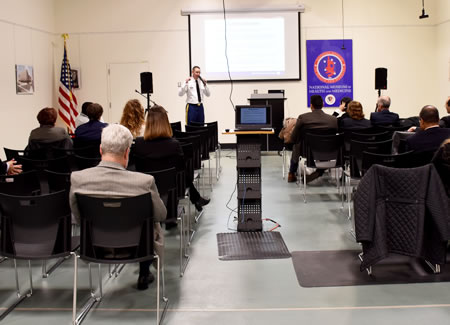A Day of Listening Brings Us Closer to Hearing Loss Solution

USAMMDA industry partners and stakeholders listen to Army Lt. Col. David Saunders, product manager for TIRM's Extremity Repair portfolio, introduce the background of Noise Induced Hearing Loss.
(Photo courtesy of Ashley Force, USAMMDA public affairs)The most delicate parts of your body are on the sides of your head.
The place where your smallest bone and muscle live: the ear. Studies have shown human ears are so sensitive that headphones at high volume, or driving in a convertible can damage them for life. Now imagine standing near an explosion, gunfire or a jet engine. Afterward, all that can be heard is ringing. Military Service Members are particularly vulnerable to extremely noisy environments, resulting in noise-induced hearing loss.
For several years, the U.S. Army Medical Materiel Development Activity has been working on an effort to find a drug that can restore hearing loss. But they need some crucial information before getting the best drug that they can for the Warfighters.
"We learned through interactions with industry that we needed to understand what our partners' concerns were before we put out a request for proposals or solicitation for a contract," said Air Force Lt. Col. Melinda Eaton, acting project manager for the Tissue Injury and Regenerative Medicine Project Management Office.
On Tuesday, USAMMDA hosted an event that allowed them to get information from their industry partners and some of their stakeholders. With that information, they will be able to tailor their request for proposals.
The information-gathering event was called Pharmaceutical Interventions for Noise-Induced Hearing Loss Industry Day, and it was held at the National Museum of Health and Medicine in Silver Spring, Maryland.
For the past 70 years, the DOD has invested in hearing conservation efforts and interventions, such as hearing protection devices and noise reduction engineering. But still, other tissue injuries get much more attention than noise-induced hearing loss.
"There's not as much awareness about noise-induced hearing loss as there should be. It's a significant problem for our Warfighters and our Veterans," said Army Lt. Col. David Saunders, product manager for TIRM's Extremity Repair portfolio and host of PINIHL Industry Day. "It's time to really focus our materiel development efforts on a tangible product."
Noise trauma is one of the most common sources of injury among Service Members, and NIHL is a leading cause of service-related disability among Veterans. Hearing injuries can have a snowball effect among Service Members. They threaten safety and fitness for duty by impeding communication, reducing situational awareness, hindering threat detection, and ultimately degrading mission effectiveness. TIRM PMO has a goal to find a hearing-loss solution for the Warfighter, and as many other people as possible.
"We tend to focus a lot on military perspective, but we also know there needs to be a civilian market for these products; otherwise, there's no incentive to manufacture them just for the military. And hearing loss is such a big issue in the military and in the civilian population that having a drug that can cover both populations is a win-win for all of us," said Eaton.
PINIHL Industry Day brought TIRM PMO one step closer toward their goal. The event consisted of overview presentations of USAMMDA, the Hearing Center of Excellence, and Military Operational Medicine, as well as one-on-one sessions and product demonstrations.
"I am happy with the turnout. This has been a good audience. I think it's just the right size to get the feedback that we need. People are asking questions, they're very involved and engaged," said Eaton.
"We are going to take into account what we've heard here, and we are going to go back and modify our request for proposals so that it's well lined with the realities of the industry and the drug development process," said Saunders.
PINIHL Industry Day will hopefully lead to a solicitation for a phase two clinical trial for one of USAMMDA's hearing drugs.
Although the microscopic hairs and tiny instruments that make up the ear are sensitive, hearing loss can be treated. USAMMDA and the TIRM PMO are dedicated to finding a solution so that hearing loss can finally be repaired.













